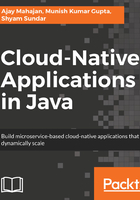
上QQ阅读APP看书,第一时间看更新
Writing Your First Cloud-Native Application
This chapter looks at the essential elements of building your first cloud-native application. We will do the minimal number of steps required to get a microservice running in our development environment.
If you are an experienced Java developer using IDEs such as Eclipse, you will find yourself on familiar turf. Though most of it will be similar to building traditional applications, there are a few nuances, which we will discuss in this chapter and summarize at the end.
The setup steps to get development going will vary based on the type of developer:
- For hobbyist, self-employed, or working-from-home developers with open access to the internet, cloud development is relatively simple.
- for enterprise developers who work on projects for customers or business teams in a closed environment and has to access the internet through a proxy, you have your enterprise development guidelines to follow. You will be constrained in what you can download, run, and configure. Having said that, the benefit of being this type of developer is that you are not alone. You have the support of your team and colleagues who can help with informal help, or formal documentation in wikis.
By the end of this chapter, you will have a cloud-native microservice running in your machine. To get there, we will cover the following topics:
- The developer's toolbox and ecosystem
- Internet connectivity
- The development life cycle
- Framework selection
- Writing a cloud-native microservice
- Enabling a few cloud native behaviors
- Reviewing key aspects of cloud development